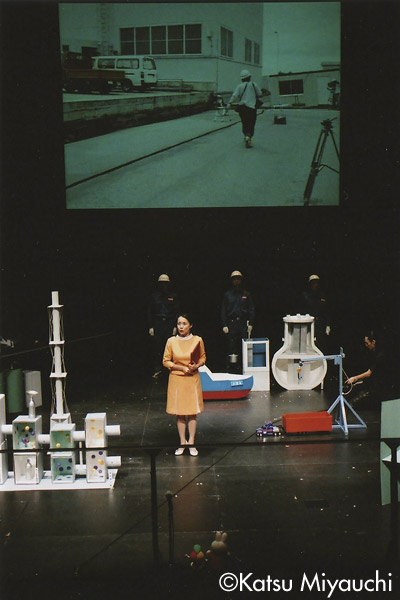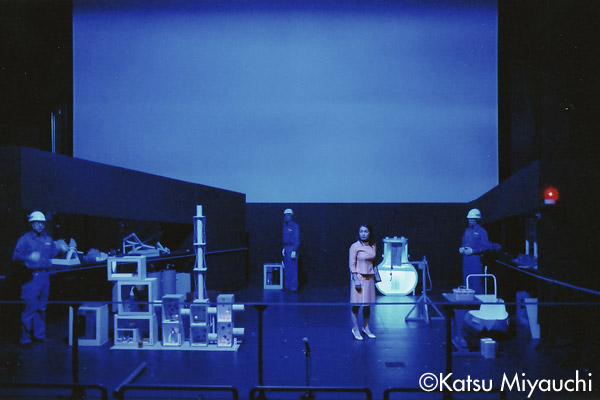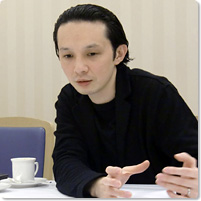

©Katsu Miyauchi
Data
:
Premiere: 2007
Length: approx. 1hr. 45 min.
Acts, scenes: 23 (incl. movie scenes)
Cast: 4 (3 men, 1 woman)
Atomic Survivor

Born in 1969. Nagashima is one of the pioneers of the dramaturge profession in Japan, performing a wide range of roles from concept proposal to editing and composing stage scripts. He has translated the works of Samuel Beckett, Jon Fosse, Sarah Kane and other foreign playwrights and has worked on the productions of directors including Hatsumi Abe, Shigeki Nakano and others.



©Katsu Miyauchi
Data
:
Premiere: 2007
Length: approx. 1hr. 45 min.
Acts, scenes: 23 (incl. movie scenes)
Cast: 4 (3 men, 1 woman)
The play begins with each of the actors giving personal comments about saving electricity.
Phrases from Brecht’s
A Short Organum for the Theatre
and Chekov’s
Uncle Vanya
are used to suggest the irreversible character of industrial development and the theoretical justification for the use of nuclear power. This section is presented in video form.
The process by which uranium is transported to Japan from France as a raw material to reconverted and shaped for use as nuclear reactor fuel is explained mainly in the tour guide’s bright and flowery narrative. And the process the audience realizes how the world’s most dangerous substance is handled by truly primitive manual processes.
Again there is a video presentation, with images of the city full of sunlight and a map showing the locations of growing number of nuclear power plants. This time lines from Chekov’s
Uncle Vanya
are used in an unaffected manner to give a sense of fatigues of people’s everyday life after welcoming the nuclear power plant in the town.
Next we see a comical dramatization of the experiences of the author of
Nuclear Power Plant Gypsy
, Kunio Horie, who was driven by his doubts about the safety of nuclear power to actually take employment at contractors working for the Mihama, Fukushima Daiichi and Tsuruga nuclear power plants.
The next video presentation once again uses lines from Chekov’s
Uncle Vanya
, this time in a narration telling how deforestation has continued at an alarming rate in just 50 years, illustrated by maps showing diminishing areas of green.
Next comes the report on the Mid Niigata Prefecture Earthquake of July 2007 and post-disaster situation of the nuclear power plant. The tour guide in her high-spirited tone explains the nuclear power industry is using the lessons from a recent nuclear power station shutdown caused by an earthquake to build even safer, more assuring nuclear power plants.
Then comes the explanation about nuclear waste processing. The uranium and plutonium extracted from the used fuel is removed from the nuclear reactor and transported to a processing plant.
There is an interjection of questions and answers between the tour guide and the visitors.
Another video presentation from Rokkashomura nuclear power plant shows the real images of facilities and the transport ship that were up to then shown as the model.
There is an explanation of the waste disposal method. The facts that waste water from washing the processing plant employees work clothes and the worn-out clothes themselves are disposed of as low-intensity radioactive waste according to a standard that requires they be buried in the ground for a period of 300 years is explained. The tour guide explains that high-intensity radioactive waste material is also buried underground and returns to the radioactive level of naturally existing uranium after about 10,000 years.
The four actors recite different lines from
Uncle Vanya
that exemplify the various logics of the people who build, support, and work at nuclear power stations.
A video with the bright and fun “Tororo Song” plays, with words that tell everyone to eat tororo kelp soup if there is a nuclear power plant accident.
With lines borrowed once again from Brecht’s
A Short Organum for the Theatre
and Chekov’s
Uncle Vanya
, closing images of hope for the future and the tragedies wrought by scientific development are delivered.
Related Tags